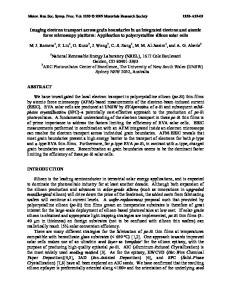The observation of various grain boundary atomic structures in Au by high-resolution electron microscopy
- PDF / 3,426,520 Bytes
- 13 Pages / 595.44 x 841.68 pts Page_size
- 38 Downloads / 336 Views
I. INTRODUCTION For a number of years the atomic structure of grain boundaries in metals has proven to be difficult to investigate directly, and the most extensively used technique for atomistic studies has been computer modeling. In a few instances, limited information has been obtained from experimental findings by diffraction contrast electron microscopy,1 as well as x-ray diffraction. However, it has recently been demonstrated that a suitably recorded high-resolution micrograph can be matched closely to a relaxed model structure for the 2 = 19/ [ 110] (331) symmetrical tilt boundary in Au.2 It is now therefore feasible that high-resolution electron microscopy can be used to directly observe and interpret the structure of a wide range of grain boundary structures in metals. The advent of the modern high-resolution microscope is a necessary but not sufficient condition for imaging grain boundaries in metals. Earlier work on grain boundaries revealed some useful information about the nature of regular crystal dislocation arrays, that is, primary relaxations.3 However, this fell short of being able to observe sufficient sets of lattice planes on each side of the interface to provide full atomic resolution in all spatial directions. Studies on Au samples using high-voltage electron microscopy, with improved resolution capabilities and backed by computer image simulations of model structures, demonstrated the need for more extensive atomistic microscopy.4'5 These attempts were not successful since no definitive interfacial structure was solved, possibly owing to photographic shot noise and specimen damage introducing imperfections in the boundary structure. The successful determination of the atomic structure of the 2 = 19/ J. Mater. Res. 1 (1), Jan/Feb 1986
http://journals.cambridge.org
[110] (331) 26.5° symmetrical tilt boundary in Au 2 stems from the investigation of microscope performance at intermediate accelerating voltages (200 and 400 kV) as well as a detailed understanding of the dependence of grain boundary images on the variation of the dynamical diffraction processes with specimen and beam orientation.6'7 This success was also facilitated by being able to improve image quality by advanced digital image processing techniques to the point where image features are recognizable. The end result of properly obtained highresolution micrographs and image processing is a structure image where each atom position is represented by a resolved white image feature. During the course of the 2 = 19 investigation, a number of other boundary structures in Au were fabricated and observed by high-resolution microscopy. It is our intent in this paper to present specific examples of these grain boundary structures, several of which have only been considered qualitatively or from the point of view of computer modeling studies. In many instances even modeling studies have not been performed, since the computation of relaxed structures would be intractable in terms of lengthy CPU times. The cases of a noncoincidence tilt bounda
Data Loading...










